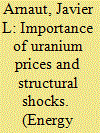| Srl | Item |
| 1 |
ID:
183126


|
|
|
|
|
| Summary/Abstract |
Over the past decade, Greenland has lifted and restored its ban on uranium mining amid the uncertainty of global uranium prices. This article investigates the dynamic interrelations between uranium commodity prices and the impacts of structural shocks, sketching key economic implications for Greenland. Using a structural vector autoregressive model, this work analyses the changing relations between uranium prices, coal prices as well as real and financial variables from 1980 to 2019. The main findings are that the dynamics of uranium spot prices are diversely affected by shocks in combined real GDP, total electricity production from nuclear power, the interest rate, the real effective exchange rate, and the price of coal. The estimates also show that the pricing dynamics are important for future production and capital investment decisions. The analysis illustrates that despite the prevailing depressed uranium market, Greenland can still capitalize on future market developments. The country can anticipate benefiting from a short-run world supply disruption, a positive combination of macroeconomic shocks, and the long-term expansion of nuclear energy programs.
|
|
|
|
|
|
|
|
|
|
|
|
|
|
|
|
| 2 |
ID:
102776


|
|
|
|
|
| Publication |
2011.
|
| Summary/Abstract |
Using the structural vector autoregression model, we estimate the current responses of monetary policy to contemporaneous shocks from macroeconomic variables. Our findings indicate that the People's Bank of China responded to inflation and output changes, but did not react to asset price fluctuations during the period from January 1997 to March 2010. The optimal monetary responses to exogenous shocks are also examined. It is revealed that using asset prices to formulate monetary policy would not help to improve monetary authorities' performance in lowering the volatilities of output growth and inflation while keeping output growth and inflation in their safety zones. The effectiveness of monetary policy and fiscal policy in reacting to external shocks is also discussed.
|
|
|
|
|
|
|
|
|
|
|
|
|
|
|
|